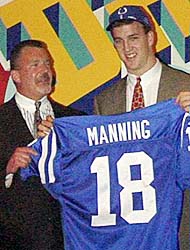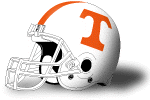

 |
 |
 |
|
INDIANAPOLIS (Nov. 4, 1998) -- Why is the number 1601 important in Colts history? No, it's not the amount of money Johnny Unitas received when he first joined the Colts in 1956. (His salary that year was $7,000 for the season.) No, it's not the year Bill Polian was born, although his appearance does seem to have more of a death warmed over-like quality as the team's losses have added up this season. No, it's not the number of injuries Jim Harbaugh sustained in his last season with Indianapolis. (That number is actually sixteen hundred and eight.) It's a number that many of us are going to be aware of a couple of years from now. You see, with his first completion to Marshall Faulk in last Sunday's game against the New England Patriots, Peyton Manning raised his total to 1,601 yards passing for the season. He went on to pass that number and ended up with 278 yards in the game, but nobody noticed when he hit 1,601. At least, nobody on the field noticed. If you're a rookie quarterback, 1,601 yards is just a statistic somewhere in the record books -- a nice number for eight games, but still just a number nonetheless. If you're Peyton Manning's accountant, however, 1,601 is more than a number -- it's like being handed a key to Fort Knox. When Manning's agent Tom Condon negotiated that monster six-year contract with the Colts this spring -- you know, the one that gave him a $10.6 million signing bonus -- there were a number of certain out clauses embedded in the wording of that contract. One of those clauses involved the number of passing yards Manning would have in his rookie season. According to the deal worked out by Condon and the Colts, if Manning threw for 1,601 yards or more in 1998, it would trigger a clause that automatically voids the last three years of Manning's deal with the Colts. In order to keep Manning in Indianapolis after the 2000 season, the Colts would have to 'buy back' the three voided years with an $8.4 million bonus and salaries of $3.2 million (2001), $4.76 million (2002) and $9.5 million (2003). Wait -- it gets better. Or worse, depending on what side of the fence you're on. Manning's not the only one who could become a free agent at the end of the 2000 season. At current count, the Colts have a dozen players who are under contract through the year 2000, including eight starters on offense. Among those who will be eligible for free agency the same year as Manning: Marshall Faulk. Currently enjoying his best season in Indianapolis, Faulk is on pace to become only the second running back in league history with 1,000 yards rushing and receiving in the same season. And when his current contract expires, Faulk will be only 27, an age when most running backs are just beginning to reach their prime. Marvin Harrison. Like Faulk, the third-year wideout from Syracuse is enjoying his best season in a Colts uniform and is on pace to set personal records for catches, receptions and touchdowns in a single season. With Manning's continued development, and with Jerome Pathon showing incremental improvement, Harrison's statistics will probably only get better the next couple of years. At this rate, he could be the premier free agent wide receiver when he becomes available after the 2000 season. Adam Meadows. After playing his entire senior year at Georgia and his first year in the league at left tackle, Meadows switched to right tackle before the start of the 1998 season to accommodate Tarik Glenn. He's done a workmanlike job so far, allowing only three of the team's 12 quarterback sacks and helping provide support for an aging Tony Mandarich at right guard. E.G. Green. The Indianapolis version of Wally Pipp, Green suffered a dislocated elbow in the preseason and has hardly been seen since, with one reception in four games. Why he isn't being used more in three receiver situations is a mystery only the team's coaching staff can explain, but with the probable departure of Torrance Small after this season, Green will have a full two years to get back in the lineup and display the same skills that made him the first pick of the third round in this year's draft. Elijah Alexander. Easily the team's best linebacker this season, Alexander's major drawback has been his inability to stay uninjured. He's missed parts of the each of the past four seasons with a variety of leg and shoulder ailments, but when healthy, as witnessed in the San Diego and Buffalo games earlier this year, he can be a ferocious tackler with a nose for the football. He'll be 30 after the 2000 season. Jason Belser. If Alexander and Tony McCoy are the heart of the Colts' defense, Belser is the team's soul, leading the Colts in solo tackles the past two years and currently ranking first in total tackles this season. Belser was also the recipient of the Unsung Hero Award from the NFL Players Association the past two years for his dedication to the game and community. He may not be well-known around the league, but at least one GM has taken notice of Belser's play -- after the 1995 season, it was none other than Bill Polian, then of the Carolina Panthers, who offered Belser a five-year contract to play in Charlotte. Those are just some of the starters and key reserves who are scheduled to become free agents after the 2000 season. Kick return specialist Aaron Bailey, starting right guard Tony Mandarich and tight end Marcus Pollard also factor into the mix, as do long snapper Brad Banta, safety Robert Blackmon and reserve lineman Tom Myslinski. So where will Polian and owner Jim Irsay come up with the money to lock up this young nucleus of talent and keep it intact? It's not as if the Colts are exactly hurting for money -- at least, not on paper. First and foremost is the revenue from the new television contract that was signed prior to this season, which will pay each team an average of $73 million per season over the next four years. If the league's salary cap were to stay at its current level -- approximately $55 million -- that would still leave roughly $18 million for signing bonuses, minus operating expenses and maintenance of the RCA Dome and its related facilities. There are other revenue streams for the Colts as well. The team will soon receive its share of the money from the new franchises in Cleveland and either Houston or Los Angeles, which could both number in the tens of millions of dollars. With new radio and marketing deals, and with the popularity of Manning in Indianapolis, the Colts could pull in an additional million or two per season to help retain players. Indianapolis might also consider raising ticket prices, which currently rank as the lowest average price per ticket in the NFL. With the arrival of Manning and a new front office in Polian and Dom Anile, the Colts season ticket base jumped nearly 10 percent over last year's totals. And according to Street & Smith's Sports Business Journal, attendance is actually up .8 percent from last year, with an average crowd of 54,409 at the RCA Dome. Thats a 90.3% capacity rate -- not bad for a team with a 1-7 record. Of course, there's always the possibility that the team could change its logo or color scheme, a la Denver or Tampa Bay. You can never rule out that idea, although it flies in the face of everything Jim Irsay has said about keeping the team and its tradition intact and in Indianapolis. When all is said and done, though, it could be this moment that Colts fans remember, not what happens at the start of next century. Virtually everything the Colts do for the next two years -- in free agency, in the college draft, and in player trades -- will be based in some part on what happened last Sunday. And it will take everything Bill Polian and Jim Irsay have to keep this team intact and bring the fans in Indianapolis what they've been waiting 15 years for -- a consistent winner. For our sake, let's hope they can pull it off.
|